instrument panel Lancia Ypsilon 2003 Owner handbook (in English)
[x] Cancel search | Manufacturer: LANCIA, Model Year: 2003, Model line: Ypsilon, Model: Lancia Ypsilon 2003Pages: 191, PDF Size: 2.45 MB
Page 13 of 191
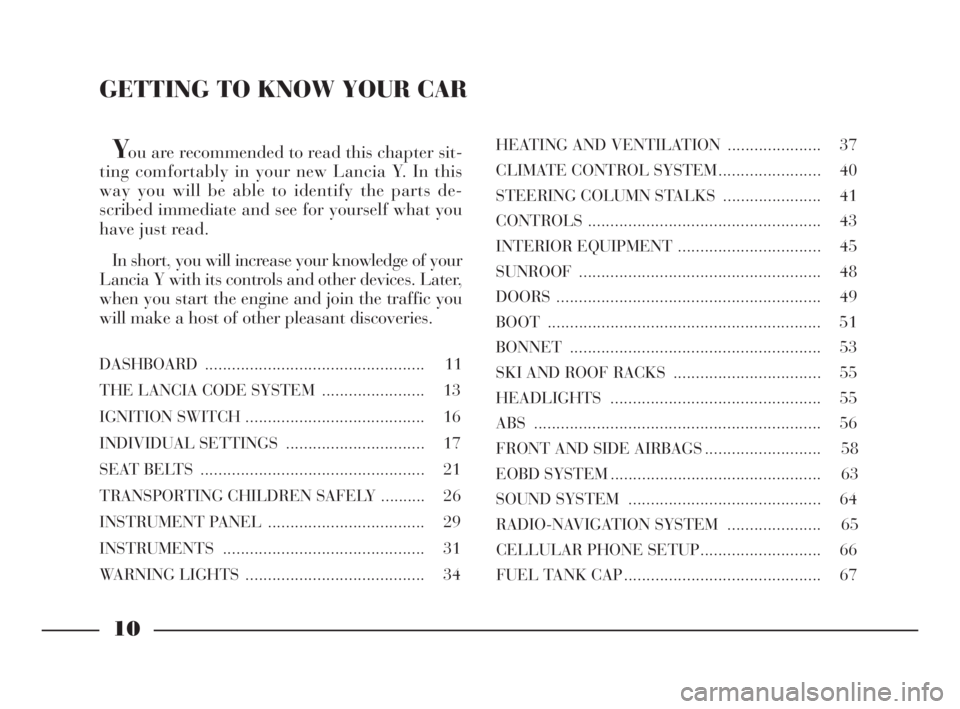
You are recommended to read this chapter sit-
ting comfortably in your new Lancia Y. In this
way you will be able to identify the parts de-
scribed immediate and see for yourself what you
have just read.
In short, you will increase your knowledge of your
Lancia Y with its controls and other devices. Later,
when you start the engine and join the traffic you
will make a host of other pleasant discoveries.
DASHBOARD................................................. 11
THE LANCIA CODE SYSTEM....................... 13
IGNITION SWITCH ........................................ 16
INDIVIDUAL SETTINGS ............................... 17
SEAT BELTS .................................................. 21
TRANSPORTING CHILDREN SAFELY .......... 26
INSTRUMENT PANEL ................................... 29
INSTRUMENTS............................................. 31
WARNING LIGHTS ........................................ 34HEATING AND VENTILATION ..................... 37
CLIMATE CONTROL SYSTEM....................... 40
STEERING COLUMN STALKS ...................... 41
CONTROLS.................................................... 43
INTERIOR EQUIPMENT ................................ 45
SUNROOF...................................................... 48
DOORS........................................................... 49
BOOT ............................................................. 51
BONNET........................................................ 53
SKI AND ROOF RACKS................................. 55
HEADLIGHTS............................................... 55
ABS ................................................................ 56
FRONT AND SIDE AIRBAGS.......................... 58
EOBD SYSTEM............................................... 63
SOUND SYSTEM ........................................... 64
RADIO-NAVIGATION SYSTEM..................... 65
CELLULAR PHONE SETUP........................... 66
FUEL TANK CAP ............................................ 67
10
G
GETTING TO KNOW YOUR CAR
4C001-067 ING 11-03-2008 11:57 Pagina 10
Page 14 of 191
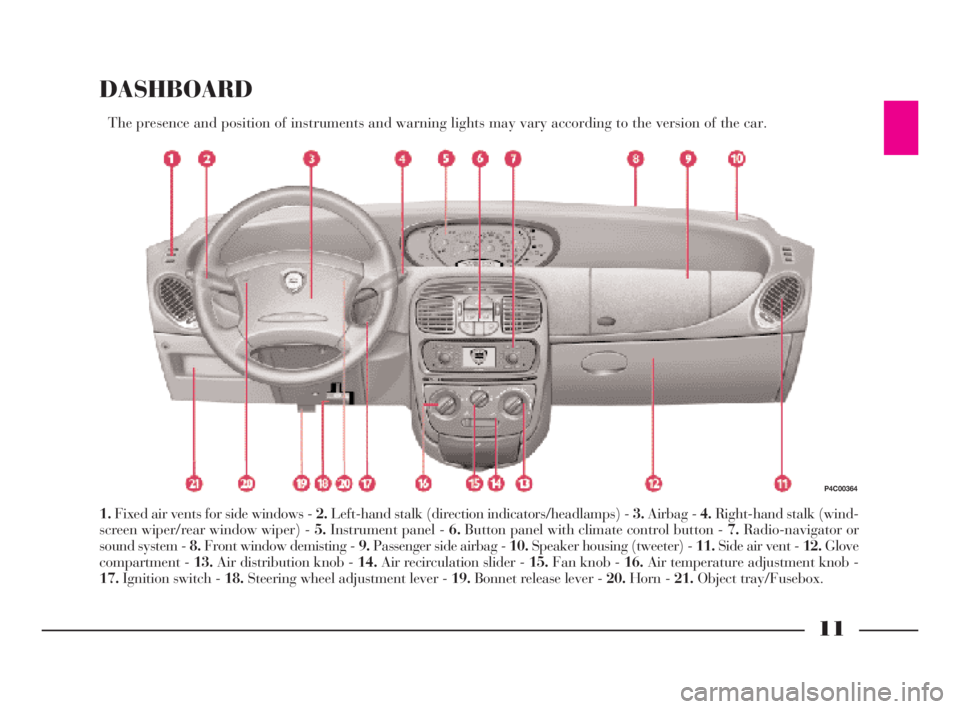
11
G
DASHBOARD
The presence and position of instruments and warning lights may vary according to the version of the car.
1.Fixed air vents for side windows - 2.Left-hand stalk (direction indicators/headlamps) - 3.Airbag - 4.Right-hand stalk (wind-
screen wiper/rear window wiper) - 5.Instrument panel - 6.Button panel with climate control button - 7.Radio-navigator or
sound system - 8.Front window demisting - 9.Passenger side airbag - 10.Speaker housing (tweeter) - 11.Side air vent - 12.Glove
compartment - 13.Air distribution knob - 14.Air recirculation slider - 15.Fan knob - 16.Air temperature adjustment knob -
17.Ignition switch - 18.Steering wheel adjustment lever - 19.Bonnet release lever - 20.Horn - 21.Object tray/Fusebox.
P4C00364
4C001-067 ING 11-03-2008 11:57 Pagina 11
Page 15 of 191
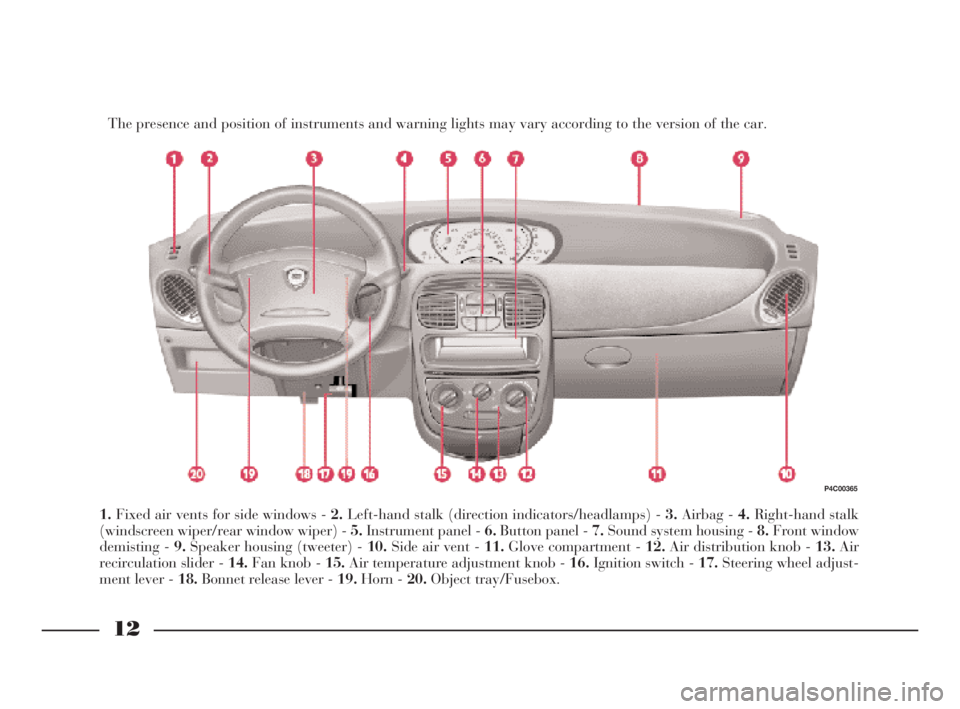
12
G
The presence and position of instruments and warning lights may vary according to the version of the car.
1.Fixed air vents for side windows - 2.Left-hand stalk (direction indicators/headlamps) - 3.Airbag - 4.Right-hand stalk
(windscreen wiper/rear window wiper) - 5.Instrument panel - 6.Button panel - 7.Sound system housing - 8.Front window
demisting - 9.Speaker housing (tweeter) - 10.Side air vent - 11.Glove compartment - 12.Air distribution knob - 13.Air
recirculation slider - 14.Fan knob - 15.Air temperature adjustment knob - 16.Ignition switch - 17.Steering wheel adjust-
ment lever - 18.Bonnet release lever - 19.Horn - 20.Object tray/Fusebox.
P4C00365
4C001-067 ING 11-03-2008 11:57 Pagina 12
Page 17 of 191
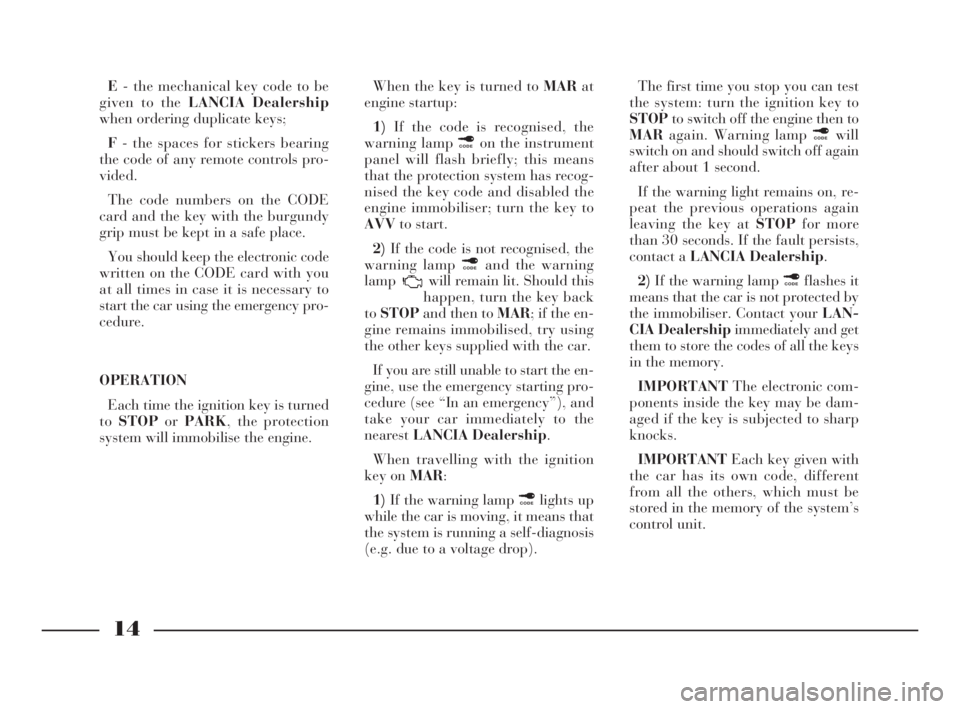
14
G
E- the mechanical key code to be
given to the LANCIA Dealership
when ordering duplicate keys;
F- the spaces for stickers bearing
the code of any remote controls pro-
vided.
The code numbers on the CODE
card and the key with the burgundy
grip must be kept in a safe place.
You should keep the electronic code
written on the CODE card with you
at all times in case it is necessary to
start the car using the emergency pro-
cedure.
OPERATION
Each time the ignition key is turned
toSTOPorPARK, the protection
system will immobilise the engine.When the key is turned to MARat
engine startup:
1)If the code is recognised, the
warning lamp ¢on the instrument
panel will flash briefly; this means
that the protection system has recog-
nised the key code and disabled the
engine immobiliser; turn the key to
AVVto start.
2)If the code is not recognised, the
warning lamp ¢and the warning
lamp will remain lit. Should this
happen, turn the key back
toSTOPand then to MAR; if the en-
gine remains immobilised, try using
the other keys supplied with the car.
If you are still unable to start the en-
gine, use the emergency starting pro-
cedure (see “In an emergency”), and
take your car immediately to the
nearestLANCIA Dealership.
When travelling with the ignition
key on MAR:
1)If the warning lamp ¢lights up
while the car is moving, it means that
the system is running a self-diagnosis
(e.g. due to a voltage drop). The first time you stop you can test
the system: turn the ignition key to
STOPto switch off the engine then to
MARagain. Warning lamp ¢will
switch on and should switch off again
after about 1 second.
If the warning light remains on, re-
peat the previous operations again
leaving the key at STOPfor more
than 30 seconds. If the fault persists,
contact a LANCIA Dealership.
2)If the warning lamp ¢flashes it
means that the car is not protected by
the immobiliser. Contact your LAN-
CIA Dealershipimmediately and get
them to store the codes of all the keys
in the memory.
IMPORTANTThe electronic com-
ponents inside the key may be dam-
aged if the key is subjected to sharp
knocks.
IMPORTANTEach key given with
the car has its own code, different
from all the others, which must be
stored in the memory of the system’s
control unit.
4C001-067 ING 11-03-2008 11:57 Pagina 14
Page 32 of 191
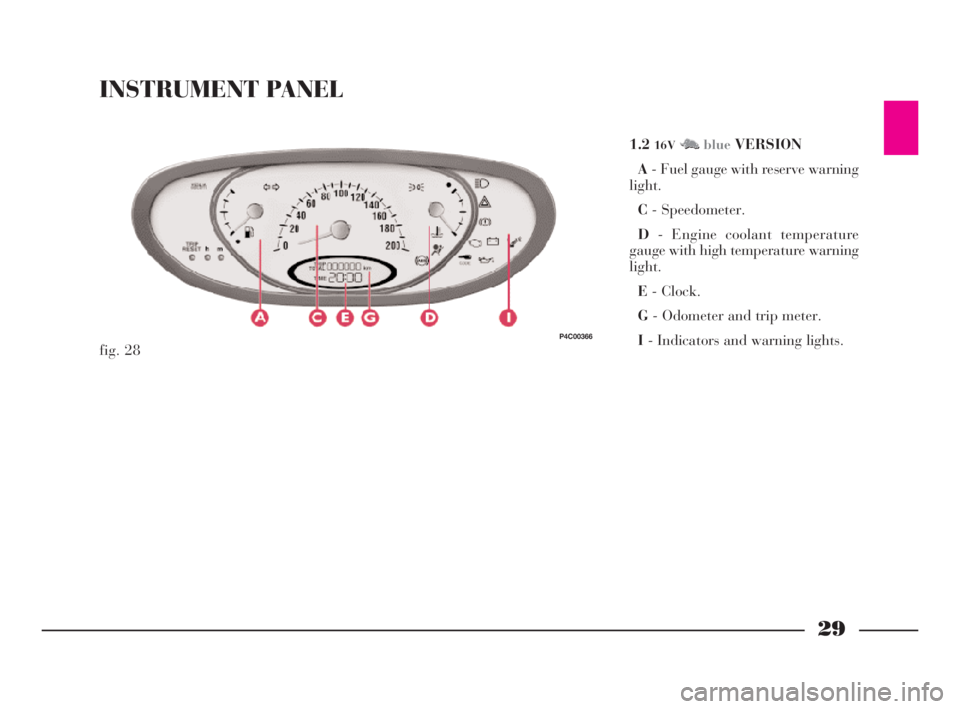
29
G
INSTRUMENT PANEL
1.216VM NblueVERSION
A- Fuel gauge with reserve warning
light.
C- Speedometer.
D- Engine coolant temperature
gauge with high temperature warning
light.
E- Clock.
G- Odometer and trip meter.
I- Indicators and warning lights.
fig. 28
P4C00366
4C001-067 ING 11-03-2008 11:57 Pagina 29
Page 37 of 191
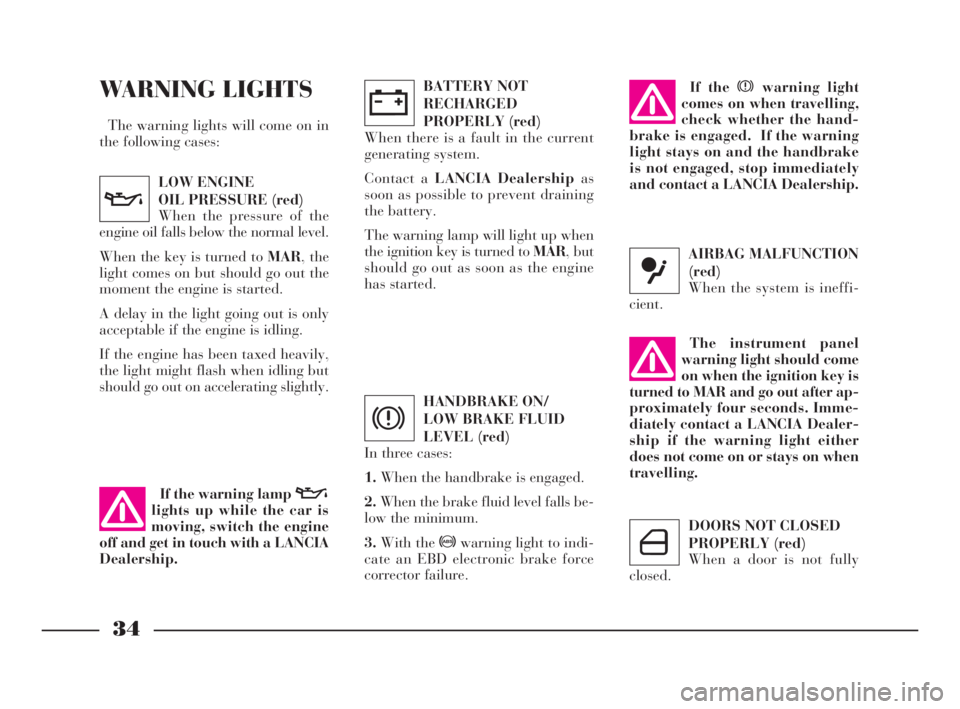
34
G
WARNING LIGHTS
The warning lights will come on in
the following cases:
LOW ENGINE
OIL PRESSURE (red)
When the pressure of the
engine oil falls below the normal level.
When the key is turned to MAR, the
light comes on but should go out the
moment the engine is started.
A delay in the light going out is only
acceptable if the engine is idling.
If the engine has been taxed heavily,
the light might flash when idling but
should go out on accelerating slightly.
v
BATTERY NOT
RECHARGED
PROPERLY (red)
When there is a fault in the current
generating system.
Contact a LANCIA Dealership as
soon as possible to prevent draining
the battery.
The warning lamp will light up when
the ignition key is turned to MAR, but
should go out as soon as the engine
has started.
w
If the warning lamp v
lights up while the car is
moving, switch the engine
off and get in touch with a LANCIA
Dealership.
HANDBRAKE ON/
LOW BRAKE FLUID
LEVEL (red)
In three cases:
1.When the handbrake is engaged.
2.When the brake fluid level falls be-
low the minimum.
3.With the >warning light to indi-
cate an EBD electronic brake force
corrector failure.
x
If the xwarning light
comes on when travelling,
check whether the hand-
brake is engaged. If the warning
light stays on and the handbrake
is not engaged, stop immediately
and contact a LANCIA Dealership.
AIRBAG MALFUNCTION
(red)
When the system is ineffi-
cient.
û
The instrument panel
warning light should come
on when the ignition key is
turned to MAR and go out after ap-
proximately four seconds. Imme-
diately contact a LANCIA Dealer-
ship if the warning light either
does not come on or stays on when
travelling.
DOORS NOT CLOSED
PROPERLY (red)
When a door is not fully
closed.
´
4C001-067 ING 11-03-2008 11:57 Pagina 34
Page 44 of 191
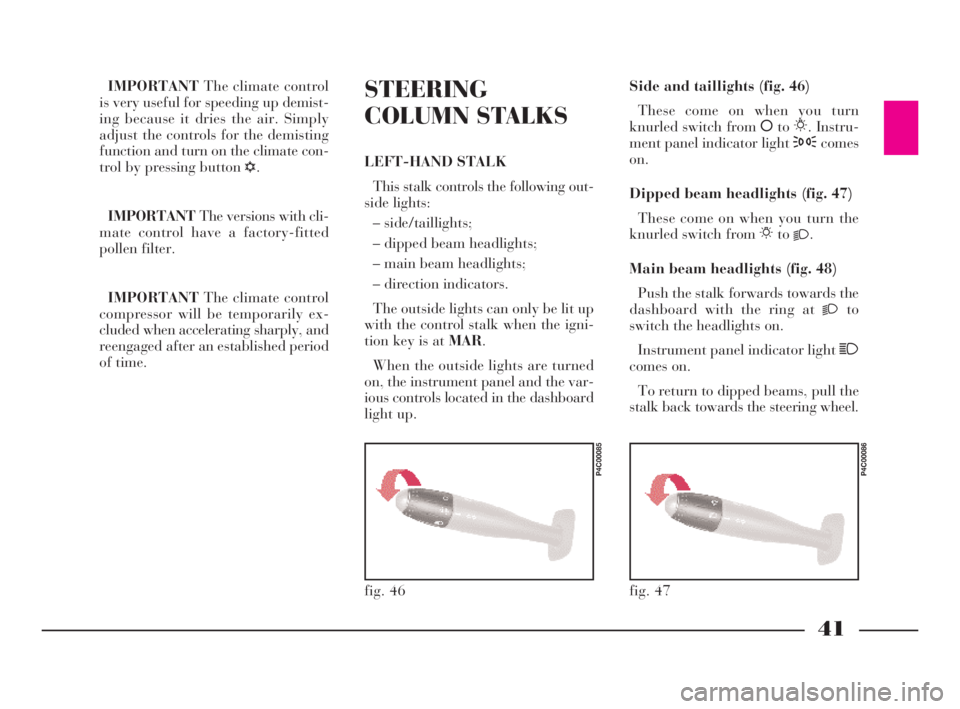
41
G
IMPORTANTThe climate control
is very useful for speeding up demist-
ing because it dries the air. Simply
adjust the controls for the demisting
function and turn on the climate con-
trol by pressing button
√.
IMPORTANTThe versions with cli-
mate control have a factory-fitted
pollen filter.
IMPORTANTThe climate control
compressor will be temporarily ex-
cluded when accelerating sharply, and
reengaged after an established period
of time.STEERING
COLUMN STALKS
LEFT-HAND STALK
This stalk controls the following out-
side lights:
– side/taillights;
– dipped beam headlights;
– main beam headlights;
– direction indicators.
The outside lights can only be lit up
with the control stalk when the igni-
tion key is at MAR.
When the outside lights are turned
on, the instrument panel and the var-
ious controls located in the dashboard
light up.Side and taillights (fig. 46)
These come on when you turn
knurled switch from åto6. Instru-
ment panel indicator light 3comes
on.
Dipped beam headlights (fig. 47)
These come on when you turn the
knurled switch from 6to
2.
Main beam headlights (fig. 48)
Push the stalk forwards towards the
dashboard with the ring at
2to
switch the headlights on.
Instrument panel indicator light 1
comes on.
To return to dipped beams, pull the
stalk back towards the steering wheel.
fig. 46
P4C00085
fig. 47
P4C00086
4C001-067 ING 11-03-2008 11:57 Pagina 41
Page 45 of 191

42
G
RIGHT-HAND STALK
Windscreen wash/wipe (fig. 51)
This feature can only work when the
ignition key is at MAR.
Controls:
0- windscreen wiper off;
1- flick wipe;
2- slow continuous wipe;
3- fast continuous wipe;
4- temporary function: when you
release the stalk it returns to position
0and automatically turns off the
windscreen wiper.
fig. 51
P4C00090
To flash the lights (fig. 49)
Pull the stalk towards the steering
wheel (temporary position).Direction indicators (fig. 50)
Move the stalk as follows to turn on
the direction indicators:
up - for the right indicator;
down - for the left indicator.
Instrument panel indicator light y
flashes.
The direction indicators automati-
cally return to the neutral position
when the car straightens up.
If you want the indicator to flash
briefly, move the stalk up or down
without it clicking into position. When
you let it go it will return to its origi-
nal position.
fig. 48
P4C00087
fig. 49
P4C00088
fig. 50
P4C00089
4C001-067 ING 11-03-2008 11:57 Pagina 42
Page 60 of 191

57
G
In the case of failure, although the
anti-locking system is no longer avail-
able, the car braking capacity is not
interfered with.
If you have never driven a car with
ABS it is advised to familiarise by
making a few preliminary trials on
slippery ground, obviously maintain-
ing safety conditions and respecting
the Highway Code of the country
where you are travelling. Before start-
ing, read carefully the notes below.
The advantage of ABS as compared
with the traditional system is that it
permits maximum manoeuvrability
even when pressing the brakes right
down on roads with poor grip, pre-
venting the wheels from locking.
However, this does not mean that
with ABS the braking distance is al-
ways reduced. For example, on soft
gravel surfaces or fresh snow on a
slippery surface the distance could in-
crease.In order to get the best out of the
anti-lock system when necessary, fol-
low these hints.
If the ABS triggers it
means that the car is
reaching the limit of ad-
herence between the tyres and the
road surface. Slow down to adapt
the speed to the road grip.
ABS exploits the avail-
able grip, but it is not able
to increase it. Therefore
drive carefully on slippery surfaces
and do not take undue risks.
If there is a system fail-
ure, indicated by warning
light>lighting up on the
instrument panel, drive slowly and
go immediately to a LANCIA Deal-
ership to have the system checked.
When braking round a bend be very
careful, even with the aid of ABS.
However, the most important advice
is the following:
When the ABS switches
on and you feel the pedal
throbbing, no not lighten
the pressure, but keep the pedal
pressed well down and do not
worry. In this way you will be able
to stop within the minimum dis-
tance possible, according to the
road surface.
Following these instructions you will
be always have the best braking con-
ditions.
4C001-067 ING 11-03-2008 11:57 Pagina 57
Page 63 of 191
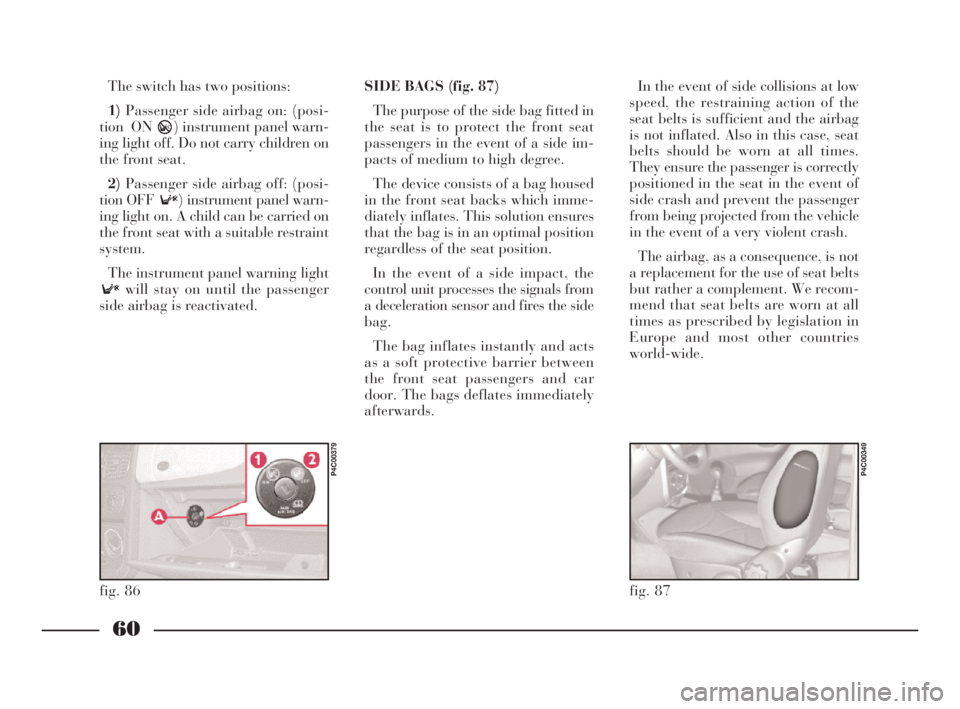
60
G
The switch has two positions:
1)Passenger side airbag on: (posi-
tion ON ) instrument panel warn-
ing light off. Do not carry children on
the front seat.
2)Passenger side airbag off: (posi-
tion OFF ) instrument panel warn-
ing light on. A child can be carried on
the front seat with a suitable restraint
system.
The instrument panel warning light
will stay on until the passenger
side airbag is reactivated. SIDE BAGS (fig. 87)
The purpose of the side bag fitted in
the seat is to protect the front seat
passengers in the event of a side im-
pacts of medium to high degree.
The device consists of a bag housed
in the front seat backs which imme-
diately inflates. This solution ensures
that the bag is in an optimal position
regardless of the seat position.
In the event of a side impact, the
control unit processes the signals from
a deceleration sensor and fires the side
bag.
The bag inflates instantly and acts
as a soft protective barrier between
the front seat passengers and car
door. The bags deflates immediately
afterwards.In the event of side collisions at low
speed, the restraining action of the
seat belts is sufficient and the airbag
is not inflated. Also in this case, seat
belts should be worn at all times.
They ensure the passenger is correctly
positioned in the seat in the event of
side crash and prevent the passenger
from being projected from the vehicle
in the event of a very violent crash.
The airbag, as a consequence, is not
a replacement for the use of seat belts
but rather a complement. We recom-
mend that seat belts are worn at all
times as prescribed by legislation in
Europe and most other countries
world-wide.
fig. 86
P4C00379
fig. 87
P4C00349
4C001-067 ING 11-03-2008 11:57 Pagina 60